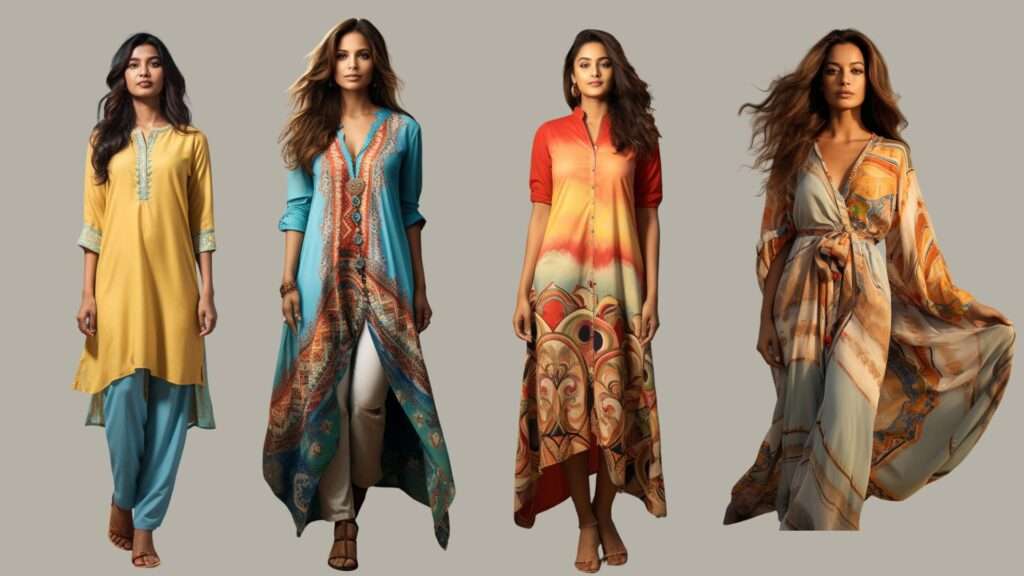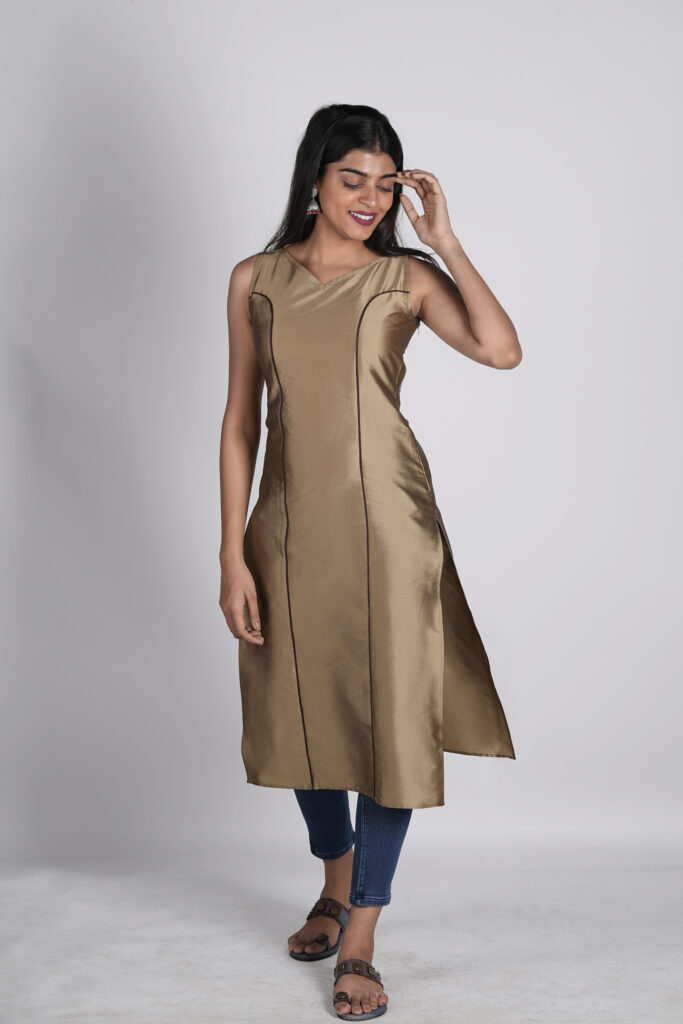Introduction
A kurta is a type of traditional or ethnic wear for women in India and other South Asian countries. It is a loose-fitting, tunic-like garment that can be worn with different types of bottom wear, such as leggings, jeans, salwar, palazzo, skirt, etc. Kurta can also be paired with a dupatta or a scarf for a more elegant look.
Kurta is a versatile and fashionable garment that can be styled in various ways to suit different occasions and preferences. There are many different types of kurta for ladies garments, depending on the style, design, fabric, length, and occasion. In this article, we will explore some of the common types of kurti and their features.
Kurta and Kurti. These two terms are often used interchangeably.
Kurta is a long and loose-fitting shirt that reaches the calf or below, while kurti is a short and fitted top that sits above the waist or at the hip. Kurta is usually worn with pyjamas or churidars, while kurti can be paired with jeans, palazzos, or skirts. Kurta is also worn by both men and women, while kurti is mostly worn by women.
Kurta and kurti also have different necklines, fabrics, and occasions. Kurta is traditionally collarless, made of light materials, and suitable for casual and formal wear. Kurti can have various collar shapes, made of feminine-friendly materials, and ideal for daily and trendy wear.

Kurta and kurti are both popular ethnic outfits in India, but they have distinct features and styles.
Types of Kurta
There are many different types of kurta for ladies garments, depending on the style, design, fabric, length, and occasion.
Some of the common types are:
• Anarkali kurta: This is a flared and fitted kurta that resembles a frock. It is usually long and reaches the ankle or the floor. It is suitable for festive and wedding occasions, as it gives a graceful and royal appearance.
• Straight kurta: This is a simple and versatile kurta that has a straight cut and falls below the knee or the calf. It can be worn with any type of bottom wear and is ideal for casual and formal wear.
• A-line kurta: This is a kurta that has a slight flare from the waist and forms an A-shape. It can be short or long and is suitable for all body types. It can be worn with leggings, jeans, or skirts and is perfect for daily wear.
• Kaftan kurta: This is a kurta that has a loose and flowing fit and resembles a kaftan. It can have a V-neck, a round neck, or a boat neck and can have slits on the sides. It can be worn with jeans, jeggings, or palazzos and is ideal for summer and beach wear.
• Shirt kurta: This is a kurta that has a shirt-like collar and buttons. It can have full sleeves, half sleeves, or sleeveless and can have pockets or slits. It can be worn with jeans, trousers, or salwar and is suitable for office and college wear.
• Asymmetric kurta: This is a kurta that has an uneven hemline and can have different cuts and shapes. It can be short or long and can have slits or layers. It can be worn with leggings, jeggings, or skirts and is ideal for party and festive wear.
• High-low kurta: This is a kurta that has a high hemline at the front and a low hemline at the back. It can have a round, a V, or a U-shaped neckline and can have sleeves or no sleeves. It can be worn with jeans, palazzos, or skirts and is perfect for casual and trendy wear
• Slit kurta: This is a kurta that has one or more slits on the sides, the front, or the back. It can be long or short and can have different necklines and sleeves. It can be worn with jeans, leggings, or salwar and is suitable for all occasions.
• Jacket kurta: This is a kurta that has a jacket or a shrug attached to it or worn over it. It can have a zip, a button, or a tie closure and can have different patterns and colors. It can be worn with jeans, palazzos, or skirts and is ideal for winter and layering.
• Flared kurta: This is a kurta that has a wide and circular flare from the waist or the chest. It can be short or long and can have different necklines and sleeves. It can be worn with leggings, jeans, or salwar and is suitable for all body types.
• Dhoti Style kurta : A dhoti style kurta is a type of ethnic wear for men and women that consists of a long top (kurta) and a pair of loose pants (dhoti) that are draped around the legs. The dhoti style kurta is a traditional Indian garment that is worn in many regions with various styles and colors. It is a comfortable and versatile outfit that can be worn on festivals, weddings, and other occasions.
• Floral Print kurta :A floral print kurta is a type of ethnic wear for women that features a pattern of flowers on the fabric. A floral print kurta can add a touch of femininity and elegance to any outfit.
• Floor-Length kurta : A floor-length kurta is a type of ethnic wear for women that features a long, flowing top that reaches the ankles. A floor-length kurta can be worn with leggings, palazzos, or skirts, depending on the style and occasion.
• Sleeveless kurta : A sleeveless kurta is a type of ethnic wear for women that has no sleeves or very short sleeves, that can be paired with leggings, jeans, or a skirt. A sleeveless kurta can be worn in summer or in warmer climates, as it allows more air circulation and comfort.

• Princess-Cut kurta : A princess-cut kurta is a type of ethnic wear for women that has shaped seams that highlight the curves of the body, which can be paired with leggings, jeans, or a skirt. A princess-cut kurta usually has three-fourth sleeves and a collar neck. It can look elegant and fashionable at the same time.
• Front-Slit kurta :A front-slit kurta is a type of ethnic wear for women that has a slit in the front, usually from the waist to the hem, that can be paired with leggings, jeans, or a skirt. A front-slit kurta can add a touch of style and flair to any outfit.
• Tail-Cut Kurta : A tail-cut kurta is a type of ethnic wear for women that has a short front and a long back, resembling a tail. It is a variation of the traditional straight kurta, and it can be paired with leggings, jeans, or skirts. A tail-cut kurta can be worn for casual, formal, or festive occasions, depending on the fabric, color, and pattern.
